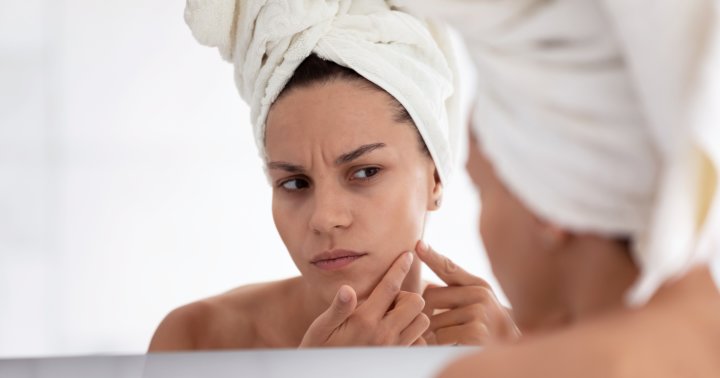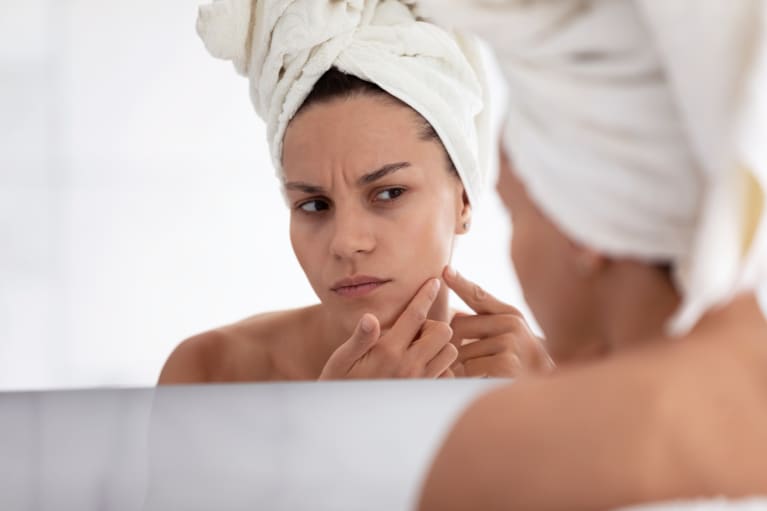The Sneaky Sign You May Have Gone Too Far With Your Retinol
It happens to the best of us.


It’s one of the most common questions regarding exfoliation: How much is too much? Quick answer: It depends on your skin type. If you have more sensitive skin, over-exfoliation can happen fairly easily, whereas those with oily skin or those who have been using exfoliating products for a longer period of time may be able to tolerate it better. Either way, anyone can overdo it.
And let’s not forget: Retinol enhances cell turnover and helps shed dead skin. In fact, it’s one of the most popular exfoliating agents used in skin care today, but it isn’t something to take lightly. It can have some unpleasant side effects if used incorrectly—that is, using it too often or a concentration that is too strong for your skin.
We suggest checking out our in-depth retinol breakdown here for a full list of side effects, but some of the most common are dry, flaky skin and an overall “tight” feeling on the face. However, there’s another sneaky giveaway you may not expect: Enter, perioral dermatitis.
What is perioral dermatitis & what does it look like?
Dermatitis is used as an umbrella term, as there are many different types, but overall, it refers to general skin irritation. (It may sound like a scary diagnosis, but rest assured—even if it's very annoying, it's very common.) With retinol misuse, dermatitis shows up most often as localized skin irritation, which includes redness and dryness, board-certified dermatologist Melanie Palm, M.D., MBA, previously told mbg. This is commonly referred to as the “retinoid reaction” or retinoid-induced dermatitis.
You may also notice tiny bumps that look like pimples but are actually part of the dermatitis reaction—and a sneaky sign you’ve gone too far with your retinol. Oftentimes dermatitis on the face will appear as perioral dermatitis, a reaction specific to the area around the mouth but can spread to the nose and under-eye area as well. These areas are more sensitive than other regions of the face, which makes it much easier to irritate the delicate skin. Skin care expert Sarah Villafranco, M.D. says it looks like “acne had a baby with eczema”—but assures that it's a very "common inflammatory skin reaction that affects the face," she says noting, "perioral means 'around the mouth.'"
What to do if you notice these signs.
If you’re starting to notice tiny bumps, redness, dry patches, or irritation after using your retinol (or any derivative of it, including retinoids), it’s time to dial it back. This may seem counterintuitive, as you may see flakes as a sign to exfoliate or mistake those red bumps for pimples caused by clogged pores, but this calls for no such thing.
We know, we know: It’s hard to stop using your favorite exfoliator, especially when beauty experts all sing its praises: That speedy cell turnover can make your skin look immediately glowy, which can make applying retinol sort of addicting. But once you overdo it, it can take a while to nurse your skin back to health. The key to recovery from retinol-induced dermatitis is to stow all exfoliating ingredients (even the sneaky ones!) and stick to a simple, hydrating routine.
Tips to nourish the skin.
Here are a few of our favorite tips to help speed up healing.
1. Stick to gentle cleansers.
Look for simple, minimal ingredient face washes so you are less likely to come into contact with an exfoliating active (for example, many cleansers can contain fruit enzymes and AHAs). We especially love washes with colloidal oat or manuka honey for dry and sensitive skin, but anything marketed as “milky” is likely a safe bet. See here for our favorite cleansers for every skin type.
2. Choose your lip balm carefully.
While the skin around your mouth is healing, it’s important to keep a close eye on what you’re putting on your lips, as the product can rub onto the surrounding area. Specifically, watch out for salicylic acid in your formulas: "It is sometimes added as an exfoliant—to help remove dry flaky skin from your lips, but the lips are sensitive, and repeated use will likely lead to irritation," says board-certified dermatologist Hadley King, M.D., about healing lip cracks. And as we noted above, exfoliating the already irritated skin is a no-go.
Instead, reach for something that’s gentle, ultra-moisturizing, and safe for sensitive skin. Our pick? The mbg lip balm, of course. Among its all-star line-up of humectants, emollients, and occlusive, it includes moringa oil to soothe and hydrate dry and irritated skin, making it a great choice for the delicate lip area.
3. Stick to soothing moisturizers.
When it comes to moisturizers, look for ingredients that help soothe and repair the skin barrier. A few of our favorites include: ceramides, naturally-derived fatty acids, colloidal oat, Manuka honey, and various antioxidants, like vitamin E or vitamin B3. We especially love these options, if you’re in the market for a new face cream.
Exfoliation can bring many benefits to your skin's appearance and overall health, but it’s easy to take it too far. With retinol, overdoing it can lead to irritation around the mouth, as the area is quite thin and sensitive. Of course, perioral dermatitis can happen for a variety of other reasons, so it’s always important to check in with a dermatologist to assess the issue. However, paring back your exfoliation regimen and sticking to a gentle routine is a great place to start.
https://www.mindbodygreen.com/articles/how-to-deal-with-retinoid-induced-dermatitis-from-derms

 MikeTyes
MikeTyes 
































